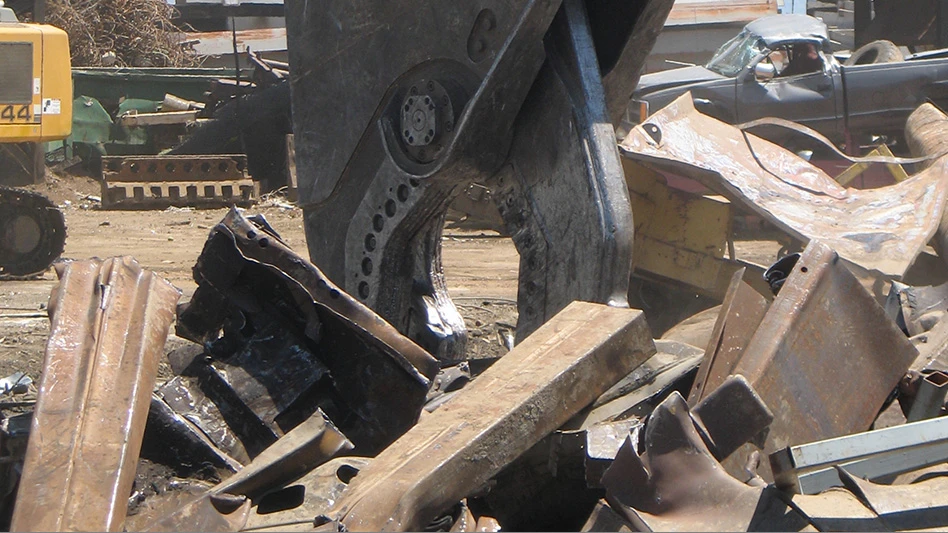If surviving tribulations and ordeals indeed makes one stronger, then the recycling industry enters 1999 in Schwarzenegger-like condition.
Recyclers of every material faced challenges in 1998, most notably in the all-important category of commodity pricing (see “A Year to Forget,” December, 1998 RT). As 1998 came to a close, many recycling and scrap industry participants were already resigned to seeing the depressed market conditions carry on into 1999. Many were hopeful, however, that positive changes might occur some time during the new year.
FERROUS HOPES PINNED ON GLOBAL RECOVERY
The numbers show that the period from July to October 1998 presented ferrous scrap dealers and processors with a daunting challenge. According to the American Metal Market composite index for No. 1 heavy melt, prices for that grade peaked in November and December of 1997 at more than $138 per ton. After $1 to $7 drops from February to July, more drastic price declines were recorded in August, September and especially in October, when $15 per ton was clipped from the price.
By the end of the year price stabilization may have been reached, but it was at a trough price of $73 per ton for No. 1 heavy melt. Hopes for a lift up from that trough price hinge on matters overseas as well as the North American steel industry’s ability to compete with cut-rate imported steel streaming in from Asia, Russia and Brazil.
The timing of the price drops coincides with events in Asia in several ways. By February of 1998, concerns that conditions in Asia would have an impact on the American economy may have contributed to the slight declines recorded that month and throughout the first half of the year.
By July, however, the consequences started becoming better known for the metals segment of the U.S. economy. Asian and eastern European steel (and eventually overseas scrap as well) began streaming into U.S. ports, alarming U.S. steel makers, many of whom curtailed scrap orders until they could assess their position in the market. Before this decrease in U.S. demand occurred, east and west coast scrap exporters were already facing a curtailment of requests for their product in Asia.
While the scrap exporters faced evaporated markets, their price at the scales was still high enough to keep their inventories high. Scrap supply began rising, while at the same time export destinations disappeared and domestic steelmakers began buying less scrap as they scaled back production.
So can the situation improve in 1999?
Jack Vexler of Monterrey Iron & Metal, San Antonio, predicts volatile ferrous scrap pricing that will at least offer occasional price improvements. “I see an easy $15 to $20 coming into the market. I think it will also disappear very quickly and then reappear very quickly,” he comments. “I expect to see two cycles by mid-year—an up, a down, an up, a down, and then it might level off at not much more than $100. That’s assuming operating rates of the mills at 70% to 75%.”
Those rates are not unrealistic, and according to the American Iron and Steel Institute, Washington, capability utilization rates did not fall under 71.8% even during the gloomiest times of 1998. “They’re going to sing the blues at those rates,” says Vexler of the steel mill operators, “and it’s certainly down from the 90% and over rates of the first half of 1998, but it’s still a decent percentage.”
Another southern scrap buyer notes that “the mills’ inventory is getting low, and in order to get dealers to start shipping, they might have to offer a few more dollars.” He adds regarding pricing, though, that “the first quarter anticipation is sideways or maybe a slight upward tick. After the first quarter, it might take up and down turns. It’s not going to come back any time in 1999 to the levels it was before this drastic decline.”
Stuart J. Simms, of Parkwood Iron & Metal, Cleveland, agrees that “it’s easy to say the market will be up in 1999. It’s been down so long, it’s got to look up. I can’t see how it can get much lower.” The optimistic version of his forecast is “to see scrap steel trading in the $120 range again. You can’t always expect to see an industry at its peak.”
Bill Heenan, president of the Steel Recycling Institute, Pittsburgh, warns that the conditions that caused the ferrous scrap price plummet have left a situation in place that could lead to a lengthy hangover. He says that even if dumped steel imports “stopped today, you’ve got three to four months of float in the system. I can’t see how the first quarter can be much better than what we have today.”
NEW YEAR RINGS IN SAME NONFERROUS CONDITIONS
A new calendar may hang on the wall at processing and brokerage offices across America, but that may be one of the few changes taking place in the nonferrous scrap sector.
Pricing of virtually every major nonferrous scrap commodity slid downward in 1998, in some cases making a bad situation worse. While processors and brokers can at least take comfort in the fact that demand is still fairly steady on the buy side, it is also fairly widely acknowledged that margins are tight and that some forms of scrap supply may be hard to come by if prices stay low.
Says one Midwestern processor, “copper is in the tank, stainless is in the tank, and I don’t see the aluminum price recovering very much in 1999.”
Regarding aluminum and copper pricing, Vexler says “I think basically they’re just kind of sitting on the bottom. I don’t think there’s anything to be very optimistic about. Pricing is soft enough that it can come back 5% or so,” he offers.
At Mallin Bros. Co. Inc. in Kansas City, Mo., Larry Mallin is “looking for 1999 volume similar to 1998. That’s what I’m looking for; what I get may be something else.” The company processes aluminum and copper cable and wire. Regarding 1999 markets and prices, he says, “I hope they don’t get any worse, that’s the main thing.”
Ansel Aberly of SLC Recycling, Warren, Mich., says regarding aluminum and copper pricing in 1999, “I find it extremely gloomy unless the American dollar falls in value. We may need the type of fall that got us out of the 1990 recession and led to the export boom. Now the dollar is so strong that the export market has fallen on its behind.”
Mallin probably speaks for several processors and brokers on the unreliability of crystal balls when he says, “I don’t trust forecasters or analysts. They’re limited by the same variables we are. It’s just a day-to-day kind of wait-and-see situation.”
PAPER MARKETS HOPE BOTTOM HAS BEEN HIT
As rough as 1999 was on metals recycling, the paper recycling industry may be able to win a “can you top this” contest for the most miserable market conditions.
In a year when collection was strong not only in the U.S. but in western Europe and other nations, demand for secondary fibers constricted first overseas and then domestically. While the overseas markets shrank due to economic slumps, some North American consuming mills were lost due to mergers and operational cutbacks within the paper and packaging industry.
1999 may be dawning with a little bit of hope, although that hopefulness can best be described as tentative. One of the hardest hit paper grades—old corrugated containers (OCC)—has seen a slight price increase due to heavy overseas ordering. There is some concern that scheduled trans-oceanic shipping rate increases will dry up the buying spree.
Joel Litman of Texas Recycling Surplus Inc., Dallas, expresses a hint of optimism when he looks forward to 1999. “From what I’m hearing, people are saying it may be rough for the first half of the year, and things will pick up in the second half,” says Litman. He hopes that “mills will run through inventory and others will get back on line and start producing again.
MUNICIPAL RECYCLING NEEDS A BOOST
The cans, bottles, and newspapers are still being collected, but there are concerns that the momentum and the enthusiasm that helped municipal recycling grow are wavering.
There are some dollars and cents reasons why the momentum might be slowing. Plummeting secondary commodity prices in 1998 would be the first culprit. “The markets continue to be depressed,” notes Robert Craags, of R.W. Beck & Associates’ Central States Office in Minneapolis. “The economic crisis in Asia has affected demand for paper products, and now the metal markets have taken a plunge.”
A drop in aluminum UBC pricing has been a particular problem for those operating municipal programs, since aluminum cans used to be one collectible that could be counted on to yield revenue. The slashing of prices paid for tin-plate steel cans has also been a detriment to recycling programs.
“It is absolutely hurting the municipalities who were getting ‘x’ dollars for their cans,” says SRI’s Heenan. “Processors were, of course, getting ‘y’ dollars from the mills. Although they’re still being collected, there has been a dramatic reduction in what is being paid. Although we haven’t seen any major municipal programs dropping cans, it has dramatically impacted one of the most stable markets.”
The tough conditions have forced municipalities and private haulers to take a closer look at how they run their programs, says Craags, which could be good news for the overall efficiency of the industry in the long run.
The conditions could help hasten a trend already well underway. “There are a lot of folks feeling pressure to privatize local government services,” says Craags. “With that pressure, it has resulted in increased scrutiny on the programs to be more efficient. In 1999, it’s likely that this trend will continue.”
Craags adds that commingled collection, which creates savings at the collection end, has become more widespread and will likely be studied further in 1999. “We’ll also be able to gather more data on commingled collection, to see how effective the new collection and processing methods have been.”
Craags probably speaks for recyclers in every segment of the industry when he says, “hopefully 1999 will bring some better markets.”
The author is the editor of Recycling Today

Explore the January 1999 Issue
Check out more from this issue and find your next story to read.
Latest from Recycling Today
- Phoenix Technologies closes Ohio rPET facility
- EPA selects 2 governments in Pennsylvania to receive recycling, waste grants
- NWRA Florida Chapter announces 2025 Legislative Champion Awards
- Goldman Sachs Research: Copper prices to decline in 2026
- Tomra opens London RVM showroom
- Ball Corp. makes European investment
- Harbor Logistics adds business development executive
- Emerald Packaging replaces more than 1M pounds of virgin plastic





